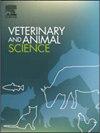南非都市小农场饲养和屠宰的猪的屠宰前操作、猪肉理化特性和脂肪酸特征
IF 1.9
Q2 AGRICULTURE, DAIRY & ANIMAL SCIENCE
引用次数: 0
摘要
对36头6个月龄长白猪的屠宰前处理、猪肉理化品质和脂肪酸组成进行了评估,这些猪来自南非开普敦大都会区低收入、高密度郊区的5个小型城市农场和1个商业屠宰场。在大型农场饲养的猪饲喂3种饲粮:(1)厨房-面包店-蔬菜废物为基础,(2)面包店-乳制品废物为基础,或(3)自制谷物为基础,而在大型农场饲养的猪饲喂商业饲粮。使用suf的猪在屠宰前要么机械昏迷,要么不昏迷。在屠杀过程中,suf要么练习喉咙,要么练习颈椎。饲喂国产谷物型饲粮的猪胴体体重、灰分、皮下脂肪和肌内脂肪(IMF)值均高于其他饲粮(P≤0.05)。自制五谷基饲粮、贴喉处理产生的猪肉ph值最高,其次是烘焙-乳废基饲粮、贴喉和厨-烘焙-菜废基饲粮、颈椎处理(P≤0.05)。商品饲粮和贴喉屠宰的猪所产猪肉的pH24、颜色坐标(L*、a*、b*、H°和C°)值较低(P≤0.05),胴体温度和剪切力值较高(P≤0.05)。饲粮中总FA、总PUFA、个体FA和总n-6 PUFA含量均高于其他饲粮(P≤0.05)。枪击昏猪的pH45、pH24和剪切力值均高于未击昏猪(P≤0.05)。自制谷物为基础的日粮改善了SUFs饲养和屠宰猪的胴体属性和脂肪酸分布,显著提高了猪肉的物理品质属性,而厨房-面包店-蔬菜废物为基础的日粮,颈椎贴贴处理导致猪肉的物理属性不理想。本文章由计算机程序翻译,如有差异,请以英文原文为准。

Preslaughter practices, pork physicochemical attributes and fatty acid profiles of pigs raised and slaughtered on smallholder urban farms in the Cape Metropole, South Africa
Pre-slaughter practices, pork physicochemical quality, and fatty acid (FA) composition of 36 Landrace barrows aged six months, sourced from five smallholder urban farms (SUFs) in low-income, high-density suburbs and one commercial abattoir in Cape Metropole District, South Africa were evaluated. Pigs on SUFs were fed three diets: (1) kitchen-bakery-vegetable waste-based, (2) bakery-dairy waste-based, or (3) homemade grain-based, while those on a large-scale farm were fed a commercial diet. Pigs on SUFs were either stunned mechanically or not stunned before slaughter. The SUFs either practiced throat or cervical spine sticking during slaughter. Carcasses from pigs fed the homemade grain-based diet had higher (P ≤ 0.05) weights, ash subcutaneous and intramuscular fat (IMF) values than those fed the other diets. The homemade grain-based diet, throat sticking treatment produced pork with the highest pH45 followed by the bakery-dairy waste-based diet, throat sticking and kitchen-bakery-vegetable waste-based diet, cervical spine treatments (P ≤ 0.05). Pigs fed a commercial diet and slaughtered by throat sticking produced pork with the lower (P ≤ 0.05) values for pH24, colour coordinates (L*, a*, b*, H° and C°) and the higher (P ≤ 0.05) carcass temperature and shear force values relative to the other treatments. Pork from pigs fed the homemade grain-based diets had higher (P ≤ 0.05) contents of total FA, total PUFA, individual and total n-6 PUFA than pork from pigs fed the other diets. Pig carcasses stunned with a gun had higher (P ≤ 0.05) pH45, pH24 and shear force values than those not stunned. The homemade grain-based diet improved carcass attributes and fatty acid profiles of pigs raised and slaughtered on SUFs, stunning enhanced pork physical quality attributes while the kitchen-bakery-vegetable waste-based diet, cervical spine sticking treatment produced less desirable pork physical attributes.
求助全文
通过发布文献求助,成功后即可免费获取论文全文。
去求助
来源期刊

Veterinary and Animal Science
Veterinary-Veterinary (all)
CiteScore
3.50
自引率
0.00%
发文量
43
审稿时长
47 days
 求助内容:
求助内容: 应助结果提醒方式:
应助结果提醒方式:


